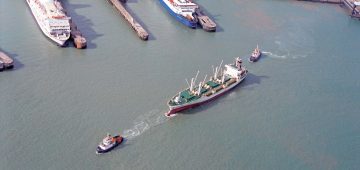Henry Frederick Swan was the 11th child (and sixth son) of William Swan a tenant farmer of 60 hectares, at West Farm at Walker, Newcastle upon Tyne, and was born on 10th September 1842.
He would become famous throughout the world for his design of the first deep sea oil tanker the Gluckauf. His creation would subsequently create a legacy that would help propel Tyneside shipbuilding to the forefront, worldwide. The idea of carrying oil in bulk, in the hull of a ship, instead of the cumbersome method of barrels, necessarily went through many stages of development before a tanker steamer was evolved.
Swan had joined the Tyneside shipbuilding company of Charles Mitchell in 1858, becoming a Naval Architect, and quickly rose in status to manage the Walker shipyard from 1865, after a three year secondment to build ironclads in Russia.
Oil which was first drilled in Pennsylvania in 1859, was being transported in various forms, but lacked a standard format.
Henry Swan, along with the design staff of other North Eastern shipyards found the problems of transporting petroleum in bulk of particular interest. Swan became a pioneer in overcoming the problems of safely transporting oil in bulk, submitting many patents to the classification society.
They built three small ships at Charles Mitchell’s yard at Low Walker, in the early 1880s with a tank in their hold for service in the Caspian Sea. John McIntyre was the Naval Architect at the Palmers Shipyard at Jarrow three miles downstream, who were also experimenting with a different form of tanker. The first to be built by Palmer’s was the 2,748grt, Vaderland for the Red Star Line of Antwerp, which was built in 1872 as a dual purpose oil tanker/passenger ship. The plan was to carry emigrants westbound and bring oil back to Europe, but it fell foul of the American longshoremen, and in the event was never allowed to carry oil. The yard did not build its first deep sea tanker until 1887.
In 1881 Mitchell’s built a cargo ship for Russian owners, the Massis of 411dwt, with a deep tank amidships, but with no onboard pumping arrangement.

Henry Swan continued to look for a solution and took his embryo design to several eminent naval architects for their opinions, and was told that it would not stand up to the North Atlantic sea states.
However the company pressed ahead to build a ship as a speculative venture, which was laid down on 25th November 1885. W. A. Riedmann, a German shipowner and oil importer, visited the shipyard during construction and placed an order for the ship, whose name Gluckauf, when translated, meant Good Luck, she launched 16th June 1886, ran trials on 10th July. She was powered by 992 I.H.P. machinery, and carried sails as standby equipment. Her first cargo of 2,880 tons was loaded at Philadelphia for Geestemunde. The Gluckauf became part of the Standard Oil fleet in 1888 until eventually wrecked in 1893.
It was not uncommon for shipbuilders to build ships for their own account to keep the shipyard in production, and then sell them when the market improved. Two tankers owned by Henry Swan, coming from the Low Walker berths, were the Lux 1,135/1888 and the Le Coq 3,390/1895. In the early days of transportation of this volatile liquid there were several ships that were lost when they blew up after stranding or due to lack of care and understanding during unloading. Lux was sold to J. M. Lennard, but caught fire and sank in November 1891 near the island of Negraport when on passage from Batoum to Antwerp, while Le Coq was managed by Lane, MacAndrews and broken up in 1932.
As pioneer builders the company were inseparably associated with subsequent developments in this class of ship. Orders for these became a regular occurrence for the yard from small independent owners, the yard producing 39 ships by 1900, Marcus Samuel & Co. being a regular customer.
Distinctive profiles emerged in 1908 when two ships were built, Cheyanne and Delphinula. The ships had two funnels in a fore and aft arrangement. Twin funnels on tankers would not be seen on the river again until the early 1960s when Vickers and Swan, Hunter completed the Serenia and Solen for Shell.
The demand for these ships grew after The Admiralty decided to switch from coal to oil for the fleet, giving lucrative contracts to several companies for its supply including Anglo-Persian Oil, Anglo-American and Eagle Oil. Anglo-Saxon were excluded as the Government were not happy about their German and Dutch trading partners. As the demand for oil progressively rose, so did the size of ships to transport it. Three shipyards on the Tyne received an order from Eagle for 17 of a 19 ship order. When San Fraterno was launched on 22nd February 1913 at Wallsend, she was the largest tanker in the world with a capacity of 15,700 tons.
The Wallsend built Eburna (7,048 dwt) was the first tanker to pass through the Panama Canal on 15th August 1914.

Subscribe today to read the full article!
Simply click below to subscribe and not only read the full article instantly, but gain unparalleled access to the specialist magazine for shipping enthusiasts.


Comments
Sorry, comments are closed for this item